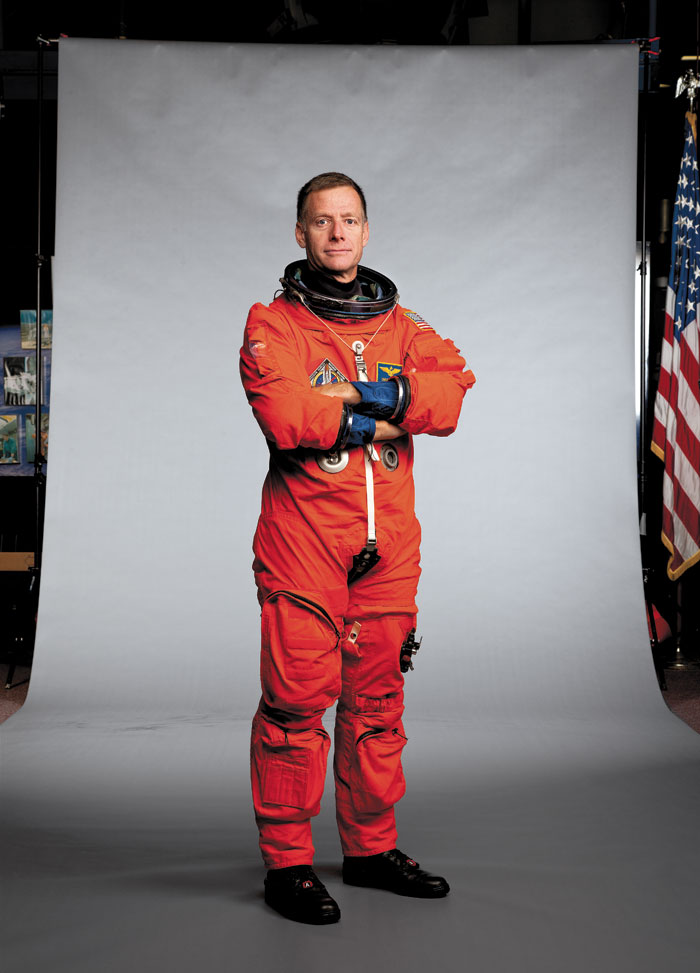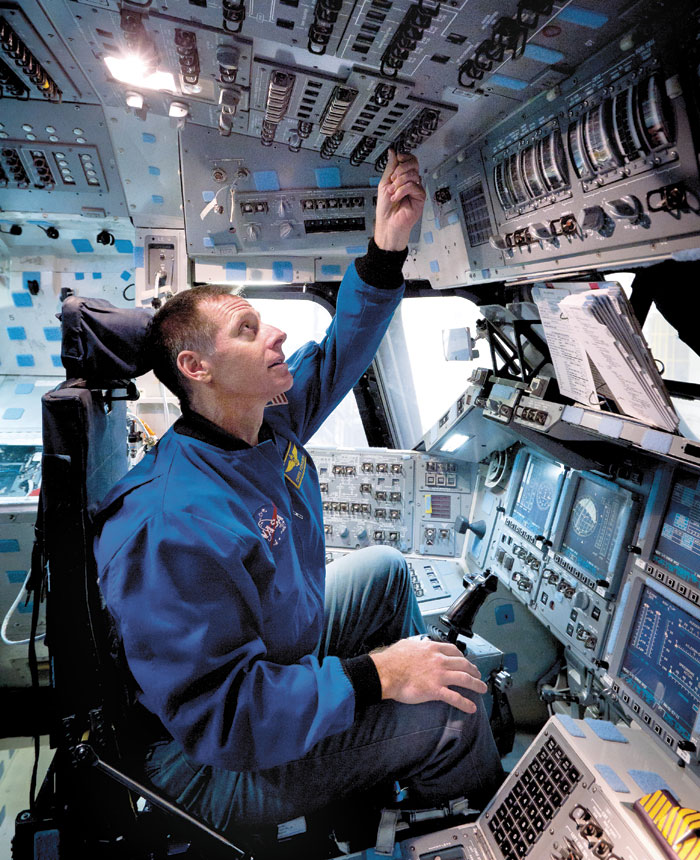On July 21, 2011, the Space Shuttle Atlantis touched down at NASA’s Kennedy Space Center after 13 days in orbit. The landing was successful, and routine, and unremarkable in most every way. Except for one.
That particular landing was not just any landing. It was, instead, not only the last landing Atlantis would ever make, but also the very last landing in the long, accomplished, sometimes tragic, and ever-controversial history of the entire Space Shuttle program—a program that, over the course of 30 years, did nothing less than transform both the practice and perception of space travel itself. That last landing, in other words, was nothing less than historic.
And Christopher Ferguson, ’84, was right in the middle of it.
Ferguson, a Philadelphia native and one of three Drexel alums to become an astronaut, capped his accomplished NASA career with perhaps the greatest honor possible: He was asked to serve as commander for the last mission the Shuttle would ever undertake—mission STS-135. It was, in some ways, a dream assignment for Ferguson, an avowed believer in the Shuttle program who said he made sure to take just one moment, the night before re-entry, to reflect on his hugely successful, entirely unexpected space-travel career, and to appreciate his unique role in American space history.
A few weeks after the mission was completed, however, with the media hoopla finally dying down and with his future (and the future of NASA itself) in doubt, Ferguson’s feelings about that last flight, and about the end of the Shuttle program, had changed.
In a nearly hour-long interview with Drexel Magazine, Ferguson admitted to being saddened by the end of the Shuttle program and bothered that its advertised replacement, The Constellation Program, was abruptly cancelled in early 2009. At the same time, Ferguson said he was optimistic for his own future (which, he says, may or may not include NASA) and bullish on America’s chances of maintaining its spot as the global leader in space exploration.
It’s been about three weeks since the end of STS-135. What have you been up to?
“The way a typical mission works is, after landing you come back to Johnson and there’s usually a three-week debrief period, which is typically intended to review what happened, to make the following mission more effective, to review what lessons where learned and make sure we don’t make the same mistakes twice. But now, given that there is no shuttle mission to make better, our debrief period was cut down to about 10 days.”
So what have you been doing instead?
“We’ve been doing what everyone does after the debrief period is over—taking the show on the road. A lot of people around the country like to hear what the latest Shuttle mission is all about, and this one holds more significance, not only because it’s the last one, but also because there’s the question of, ‘OK, since this is the last one, what’s next?’ We’re trying to help deliver that answer, even though the answer isn’t quite what we want it to be, and isn’t quite clear yet.
Last week we started out at the Texas Legislative Summit, where I got to meet Gov. [Rick] Perry from Texas. I addressed a small audience in the morning and then went to New Orleans, to the company that made the Shuttle’s external tanks for the last 30 years, then up to Mississippi, where they test our rocket engines. Then we were off to Huntsville, where they manage some really large Shuttle projects—everything except the shuttle itself, the tanks and the boosters. Then we were up in New York for two to three days and had the opportunity to go on some national news media outlets, and next week we’ll be in Los Angeles. After that, our names go back in the hopper and we’re just regular people again. It’s a different world now that the Shuttle is gone.”
It’s an obvious question, but one that needs to be asked: What exactly do you do now?
“Well, back in the Shuttle era, there were six to eight flights a year, and six to seven seats each. Now we’re down to the Space Station only, and there are only four slots each year for U.S. astronauts. So the folks who have been flying already are asking themselves what this all means for them. We are all going to be asked, ‘What now?’ And we’re all trying to interpret what the future holds, not only for our future as astronauts, but also globally [regarding space travel] and locally at Johnson Space Center.”
“If you remain focused, and do your job well, you never know where you’re going to end up.”
Obviously, the decision has been made to ‘commercialize’ American space travel, to a certain extent—to get NASA out of the business of getting astronauts to and from the Space Station. Is this a good idea?
“It depends who you talk to. The NASA political appointees who were installed under the current administration are very optimistic about [commercial carriers] getting us into low-earth orbit. But the whole ‘commercial’ angle is a bit of a misnomer. There have always been commercial companies that have built the Shuttle hardware in the past. NASA managed the program, but commercial firms handled a lot of the construction. Now commercial firms are going to manage and construct the vehicles that are going to carry passengers up to the Space Station. In theory, that frees up a lot of resources and money to once again set our sights beyond just low-earth orbit—to destinations yet to be determined. Maybe the moon, or maybe Mars. But overall, I would say that there are some who are very optimistic about the new focus, and others who are very concerned.”
One of the entrepreneurs who is taking over space travel from the private side is Elon Musk, the founder of both Tesla Motors and SpaceX. Musk sounds very confident about his ability to handle this task. Do you think he’s up to it?
“Well, he’s certainly a very interesting guy, and I have a lot of respect for the businesses he’s run over this lifetime. I hope he succeeds; I really do, because our nation’s access to low-earth orbit depends on him and companies similar to SpaceX. And when it comes to something like this, you need to give it to somebody who has confidence in what they’re doing. That being said, confidence does not get people back and forth to space safely. We learned a lot of extraordinarily difficult lessons over the years, and my concern is that we’re casting aside all of the people who learned those lessons the hard way, in favor of a cheaper and perhaps more efficient way to low-earth effort. Time will tell.”
It seems like this change in focus at NASA was rather sudden—that one day we were living with the status quo, and the next we had decided to privatize. But it’s got to be more complicated than that, correct?
“Yes, it is slighly more complicated than that. The opinions of NASA have their foundation in the appointees who are installed with the sitting presidential administration. They, in effect, become “NASA.” So when NASA became the Obama administration, this was their plan, and anything that was put out publicly was, ‘NASA supports this,’ or ‘NASA wants this.’ Meanwhile, the guys down at Johnson were beside themselves, wondering if we were going to give up everything we had worked for in order to take a new approach that was, in theory, faster, better and cheaper. This has always been something of a challenge for us. NASA speaks with one voice—a very small group who says, ‘This is the way we’re going to be.’ But the rest of us, as always, remain very loyal. As for the plan itself, it’s really going to take a while for everyone to absorb it and understand the implications.”
What should America’s goal be in the realm of space exploration? What should we be aiming for?
“Well, if you’re asking what’s feasible—what is technologically possible—then the answer is that it is entirely possible, given today’s technology, to go to Mars. The question is what it would cost. When Apollo was putting a man on the moon, a full 5 percent of the entire federal budget was going to NASA. And 5 percent is a huge number. Today, NASA’s budget is about .5 of 1 percent of the federal budget, and with that kind of money, we can go into low-earth orbit, we can man the Space Station, but we can’t do what they did in the 1960s. But again, if money wasn’t an object, we could go to Mars.”
“We learned a lot of extraordinarily difficult lessons over the years, and my concern is that we’re casting aside all of the people who learned those lessons the hard way.”
You really believe that?
“Yes. I think we were on a pretty good track back before the Constellation program was cancelled. We were at that time building a vehicle that could leave low-earth orbit, that could go to the moon, that could land a vehicle on the moon. And it wasn’t just something that could land and stay for a day or two. It could have brought equipment, it could have helped us build places to stay, it could have provided power generation to set up camp on the moon for six months at a time. Now, some would say that we’ve been there and done that, but I believe it’s important to go back. We need to perfect—and I don’t mean ‘make better,’ I mean perfect—a system that will sustain human life in space for a long period of time. We need to figure out air recycling. We need to figure out water recycling, which is a huge technological challenge. Taking water to space is very difficult and very expensive, but if there’s water that exists in the lunar atmosphere and we can get at that water, then you can basically do anything. While you’re there, you can perfect your systems for recycling your elements, and when you head out to Mars, when it’s going to be three years for everyone to get there and get back, you’ll know it will work, because you’ve perfected the system ahead of time. And the place to do that is the lunar surface.”
You’re saying that all of this is possible. But is the ambition there? Does this nation really want to make the effort?
“In reality, I think when the economy gets better and we have a few extra bucks to spend, we might throw some of that at NASA. But I don’t think we’ll do anything of significance until the Chinese become a significant threat in space. When China sets up camps on the moon, that’s when we’ll say, ‘Oh boy, we need to get going.’ Because when it becomes a national security issue, ears perk up.”
Let’s go back to the Shuttle for a moment. Some have said the program was too expensive, or that it didn’t achieve what it was supposed to achieve—namely, making space flight cheap and easy. What is your response to that? What is the program’s real legacy?
“My answer to that has changed over the months, and believe me, we [astronauts] get that one a lot. So how is history going to view the Shuttle? My canned answer would be that the Shuttle program made low-earth orbit a great deal more accessible. But it also allowed us to build the Space Station. It’s hard for somebody who doesn’t have a background in construction or space exploration to understand this, but the reality is, before we had the Space Shuttle, we were extremely limited as far as what kind of equipment and material we could put on a traditional rocket. With the Space Shuttle, the payload bay was 15 feet wide.”
Why is that important?
“When you look at the American section of the Space Station and then the Russian section, you can see why this matters. The Russian section is filled with narrow little passageways—you can just barely squeeze by each other. The American section is a lot more open, which enables you to work in three dimensions. You can work on the ceiling, on the walls, on the floor. The Russian segment is just a hole. If we didn’t have the Shuttle, we would today have a much smaller and less habitable Space Station. So I would say the size of the Shuttle—the ability to carry large, heavy things into space at will—was a huge advantage. There’s another element here, and it’s so telling: In the most recent book that NASA put out about the Shuttle, Wings In Orbit, there’s a point they make that reminds me of another reason why we’ll miss the Shuttle—we’re going to lose the ability to bring home things from space. I would guess that, if you really looked at it, about 98 percent of the total mass returned to earth from space was carried on the Shuttle. On this most recent mission, we had a pump module [from the Space Station] fail, and we wanted to know why it failed. Well, without the Shuttle, we can’t bring it home to find out. Now, that may seem insignificant, but it really is a big deal. The next vehicle is going to be a capsule, and it’s only going to be able to bring people back. So the list goes on and on.
It was a huge program, so you can of course poke holes in it all you want. We built it back in the 1970s and we didn’t really know what it was going to do, and in truth it ended up doing some things we never thought it would do. The folks who put this program together were true visionaries. And the program was a success because we had support for the people who knew how to make these decisions.”
Are there are any space exploration visionaries out there today? Can we do something great again?
“Yes. This country is filled with incredibly talented people with tremendous ideas. We’ve come up with a lot of vehicles over the years for a various number of [goals]. We have the ability to do fantastic things. What we suffer from is having far too many people who don’t have either the technological background or understanding of physics meddling in the business of people who actually want to get things done. I may be sounding overly negative on the political process, but we’ve had [great ideas] over the past 10 years or so that would have worked. But we’re caught in this cycle where, whenever a new administration comes in, they feel they need to put their own label on everything. It has happened with Democrats and Republicans. I have been espousing the idea that we need a 10- or 20-year plan which is approved by Congress so that subsequent administrations cannot come in and dither with it. We need to pick a direction and go in that direction. Because we lose a lot of credibility with the public when we cancel these programs.”
Has it always been this way?
“We are focused on achieving political goals more so than when I first got here. In the 1960s, we were building a rocket every three years. Maybe we’ve just forgotten how to be that innovative. We’ve had so many fits and starts lately. We’re just kind of floundering. And again, with every system cancellation, we lose a lot of credibility.”
We’ve spent a lot of time talking about the future of NASA. What about your future? What’s next for you?
“I’ve been there 13 years now. And you know what? I don’t have to stay in the space business. I’ve had a few unique offers come my way. I’ve had people ask me, ‘How about politics?’ And I’ll tell them, ‘Hey guys, one thing at a time.'”
Finally, I’m curious—here you are today, having just served as the last Commander of the last Space Shuttle mission of all time. Was this your plan all along? Did you believe you were going to be an astronaut?
“Heck no. I was raised in a middle-class household in Northeast Philly. I never envisioned this in a million years. You asked me earlier about a moment when I may have realized the significance of that last flight. Well, there was one moment, the night before re-entry. It was a moment when we figured we would be very busy. But we had finished all of our work on time, and so we had some time to just look out the window. And I’ll tell you: Everyone has a moment in his or her life, maybe when you’re looking out over an open ocean, we can just reflect for a bit. And there I was, sitting in the Commander’s post on that spaceship, looking at the Earth down below, and knowing I was there for the last flight of the Shuttle. Now, if you had asked me 15 or 20 years ago if I thought that would be possible, it wouldn’t have even been in the picture. But I guess the lesson is, if you remain focused, and if do your job well, you never know where you’re going to end up.”




